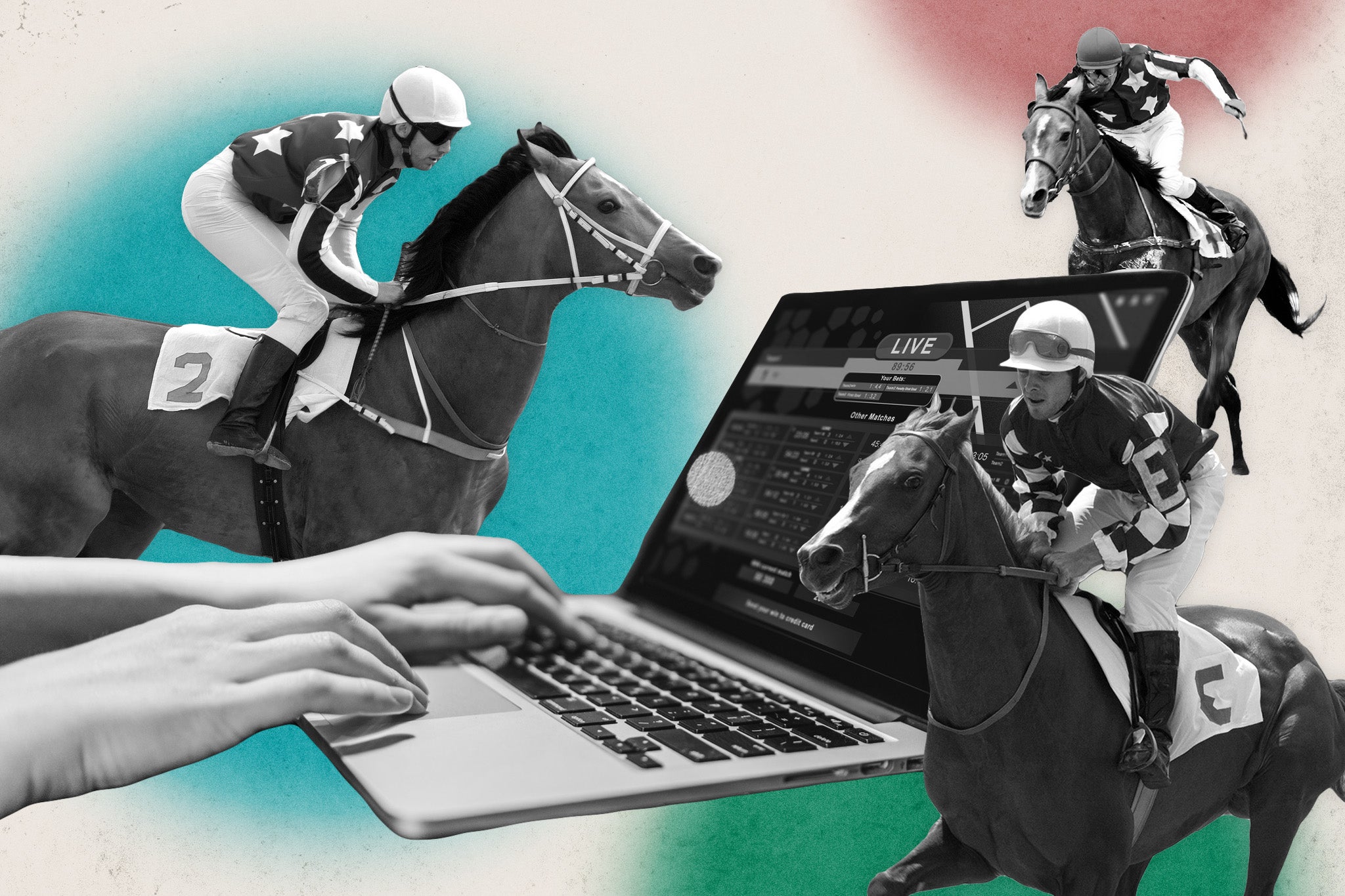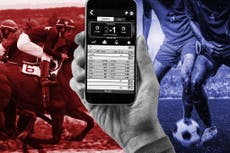The Independent's journalism is supported by our readers. If you click links to other sites on this page, we will earn commission.
What is a reverse forecast?
A beginner’s guide to reverse forecast betting, what it is and when to use it

New customers can expect a plethora of bet types, markets and sports to bet on when signing up for a betting site.
Each bet type offers potential returns and various levels of risk, so it’s a good idea to be well versed in the world of betting before placing a bet online.
Understanding the different bet types can go a long way in providing more excitement and knowledge for punters before they place their bets so we’ll be explaining one of the more common ones in this article: a reverse forecast.
Below we’ll explain how reverse forecast bets work, when they’re used and how to calculate the possible payouts when placing a reverse forecast bet.
What is a reverse forecast?
A reverse forecast is a bet on the first two finishers in a race regardless of the order they finish in.
It is like two straight forecast bets - where you choose the first two horses in a particular order - combined into one bet so that it does not matter what order the two selections finish in as long as they place in the top two.
As a reverse forecast includes two forecasts, the stake is twice as much, so a £5 reverse forecast will cost £10 as the total stake. Reverse forecasts are prevelant bets in both horse racing and greyhound racing.
How does a reverse forecast work?
Reverse forecasts can be a touch tricky to get your head around so we’ve broken down exactly how they work into simple steps below.
- Step 1: Select your bet - To start, find the option for ‘forecast’ on your horse racing betting site then select the ‘reverse forecast’ option. There are a lot bet types you can choose from so make sure you choose the right option before proceeding.
- Step 2: Make you selection(s) - Select which two horses/greyhounds you think will probably finish first and second in the race. For a reverse forecast this doesn’t have to be in any particular order. You just need to pick the two selections you think are the top two contenders.
- Step 3: Check the odds - Every horse/greyhound in a race is given specific odds that reflect how likely they are to win the race. As a guideline, the lower the odds are for a selections the higher their chances of success will be. Though this is not a guarantee.
- Step 4: Place your stake - You must decide how much money you want to bet on your forecast. Keep in mind that the potential payout will depend on both the odds and the total amount of money you’re staking. Higher odds and bigger stakes lead to better returns but also increase the risk of losing. Remember with reverse forecast bets, the stake is twice as much as straight forecast bets.
- Step 5: Calculations - The traditional way to place reverse forecast bets is by using the CSF (Computer Straight Forecast) which is an algorithm that determines the payout in dividend form specified as the return from a £1 bet. As the CSF is specified as a dividend a straight forecast bet may show a dividend of £5.43. This means that for every £1 you wager, you would get £5.43 back. No dividend is specified for reverse forecasts as only one of the two selections can win and so the declared payout is based on that result. You will have to wait until after the race to know how much you will win. The CSF is the same with every bookmaker with the dividend figure being published shortly after the race and winnings paid out depending on the stake.
- Step 6: Potential Winnings - Say you placed a reverse forecast on Horse A to finish first and Horse D to finish second in Race 4. You would also be betting that Horse D finishes first and Horse A comes second. If either of these scenarios happens, your bet is successful. The CSF will then calculate the dividend figure which will be used in conjunction with your stake to generate your winnings.
Reverse forecast vs straight forecast
These are two different but very similar bets. A straight forecast, commonly known just as a forecast, is a bet you place on two selections finishing in the first two places in a particular order. For example, Horse M will finish first, Horse Z will finish second.
In comparision, a reverse forecast covers both options. Using the above example, a reverse forecast would pay out if Horse M finishes first and Horse Z finishes second but also if Horse Z finishes first and Horse M finishes second.
As such, reverse forecast stakes are double the amount of straight forecasts. Reverse forecast bets are an option for covering your bases, especially in those tight races where there is little to choose from between two outstanding competitors.
When to use a reverse forecast
Reverse forecasts are good bets to use in races where there are two clear standouts but it is difficult to determine which is the better selection. It is a bet designed to cover all bases but also offers lower returns than a straight forecast.
Another scenario where a reverse forecast might be useful is in a race where you think a favourite could struggle based on conditions or other factors. If the favourite is highly opposable then a reverse forecast on two horses at longer odds could be worth the risk.
Customers can also take advantage of free bets and other promotions to use on a reverse forecast bet.
These mitigate the risk by using free bets rather than real money, while promotions such as extra places or price boosts give users the chance to succeed with the bet more so than in usual circumstances.
Using a reverse forecast calculator
Betting website and betting apps, especially those with strong horse and greyhound racing links, will offer reverse forecast calculators to determine the potential payouts of making the bet.
These take into account, among other factors, the price of the stake and the odds of the horses in the forecast.
Reverse Forecast bets cannot be calculated prior to the start of the race as the forecast terms are announced once the race has been run.
Advantages and disadvantages of reverse forecast betting
Here we’ve listed some of the pros and cons to reverse forecast betting:
Pros | Cons |
Easier to win than straight forecasts with both options for selections covered | It can be a high risk, high reward bet |
It’s simple enough to understand, pick two horses to finish first and second in a race | Stake is twice the size of a straight forecast alternative |
Potential returns are high due to difficulty in selecting both first and second place finishers | Complexity of predicting exact outcomes makes it a very difficult bet to win |
Remember to gamble responsibly
Please gamble responsibly. Betting is not and has never been a foolproof way to make money. It should only be considered a form of entertainment so only bet what you can afford to lose.
When using gambling sites or betting apps be aware that sports betting can be addictive so please take steps to remain in control of your time and budget.
The same applies whether you’re using new casino sites, slot sites, casino sites, casino apps, or any other gambling medium.
It’s particularly important not to get carried if you receive a casino bonus or free bets, which are available in abundance on gambling sites, but must be approached with caution.
There are several charities and healthcare providers should you wish to seek help for gambling-related issues. The providers below offer guidance support and information.
We may earn commission from some of the links in this article, but we never allow this to influence our content. This revenue helps to fund journalism across The Independent.
We aim to offer every online gambler and reader of The Independent a safe and fair platform through unbiased reviews and offers from the UK’s best online gambling companies.
Gambling can be addictive, always play responsibly and only bet what you can afford to lose. Gambling sites have a number of tools to assist you to stay in control, including deposit limits and time outs. If you think you have a problem, advice and support is available for you now from BeGambleAware or Gamcare.
Any offers or odds listed in this article are correct at the time of publication but are subject to change. Terms & Conditions apply to all offers.





